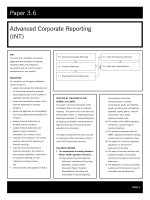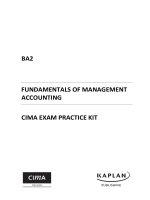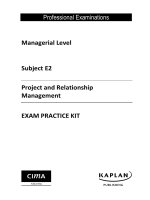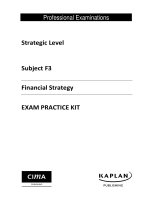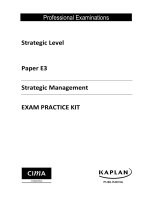ACCA paper f2 advanced financial reporting exam practice kit
Bạn đang xem bản rút gọn của tài liệu. Xem và tải ngay bản đầy đủ của tài liệu tại đây (249.99 KB, 16 trang )
Professional Examinations
Managerial Level
Subject F2
Advanced Financial Reporting
EXAM PRACTICE KIT
SU B J E CT F 2 : A DV AN CE D FIN AN CI AL RE P OR T IN G
British Library Cataloguing-in-Publication Data
A catalogue record for this book is available from the British Library.
Published by:
Kaplan Publishing UK
Unit 2 The Business Centre
Molly Millar’s Lane
Wokingham
Berkshire
RG41 2QZ
ISBN: 978-1-78415-939-9
© Kaplan Financial Limited, 2017
The text in this material and any others made available by any Kaplan Group company does not
amount to advice on a particular matter and should not be taken as such. No reliance should be
placed on the content as the basis for any investment or other decision or in connection with any
advice given to third parties. Please consult your appropriate professional adviser as necessary.
Kaplan Publishing Limited, all other Kaplan group companies, the International Accounting
Standards Board, and the IFRS Foundation expressly disclaim all liability to any person in respect
of any losses or other claims, whether direct, indirect, incidental, consequential or otherwise
arising in relation to the use of such materials. Printed and bound in Great Britain.
Acknowledgements
This Product includes propriety content of the International Accounting Standards Board which is
overseen by the IFRS Foundation, and is used with the express permission of the IFRS Foundation
under licence. All rights reserved. No part of this publication may be reproduced, stored in a
retrieval system, or transmitted in any form or by any means, electronic, mechanical,
photocopying, recording, or otherwise, without prior written permission of Kaplan Publishing and
the IFRS Foundation.
The IFRS Foundation logo, the IASB logo, the IFRS for SMEs logo, the “Hexagon Device”, “IFRS
Foundation”, “eIFRS”, “IAS”, “IASB”, “IFRS for SMEs”, “IFRS”, “IASs”, “IFRSs”, “International
Accounting Standards” and “International Financial Reporting Standards”, “IFRIC” and “IFRS
Taxonomy” are Trade Marks of the IFRS Foundation.
Trade Marks
The IFRS Foundation logo, the IASB logo, the IFRS for SMEs logo, the “Hexagon Device”, “IFRS
Foundation”, “eIFRS”, “IAS”, “IASB”, “IFRS for SMEs”, “NIIF” IASs” “IFRS”, “IFRSs”, “International
Accounting Standards”, “International Financial Reporting Standards”, “IFRIC”, “SIC” and “IFRS
Taxonomy”.
Further details of the Trade Marks including details of countries where the Trade Marks are
registered or applied for are available from the Foundation on request.
This product contains material that is ©Financial Reporting Council Ltd (FRC). Adapted and
reproduced with the kind permission of the Financial Reporting Council. All rights reserved. For
further information, please visit www.frc.org.uk or call +44 (0)20 7492 2300.
P. 2
CONTENTS
Page
Index to questions and answers
P.5
Examination techniques
P.7
Syllabus guidance, learning objectives and verbs
P.9
Approach to revision
P.13
Section
1
Objective test questions
2
Answers to objective test questions
3
References
1
91
155
This document references IFRS® Standards and IAS® Standards, which are authored by the
International Accounting Standards Board (the Board), and published in the 2016 IFRS Standards
Red Book.
Quality and accuracy are of the utmost importance to us so if you spot an error in any of our
products, please send an email to with full details.
Our Quality Co-ordinator will work with our technical team to verify the error and take action to
ensure it is corrected in future editions.
P. 3
SU B J E CT F 2 : A DV AN CE D FIN AN CI AL RE P OR T IN G
P. 4
INDEX TO QUESTIONS AND ANSWERS
OBJECTIVE TEST QUESTIONS
Page number
Question
Answer
Sources of finance (Questions 1 to 30)
1
91
–
Long term finance
1
91
–
Cost of capital and yield to maturity
3
92
7
95
Financial reporting (I) (Questions 31 to 88)
International accounting standards
–
IAS 32 & 39 Financial instruments
7
95
–
IFRS 2 Share based payments
13
100
–
IAS 33 Earnings per share
15
101
–
IAS 17 Leases
17
103
–
IAS 18 Revenue
19
104
–
IAS 37 Provisions, contingent liabilities and contingent
assets
21
105
–
IAS 11 Construction contracts
22
106
–
IAS 12 Taxation
24
107
–
IAS 24 Related parties
25
108
26
108
Financial reporting (II) (Questions 89 to 152)
Consolidated financial statements
–
Basic groups
26
108
–
Complex groups (indirect holdings)
35
116
–
Changes in groups structure
37
119
–
Consolidated cash flow statements
45
123
–
Foreign currency consolidations
48
125
Analysis of financial performance and position
(Questions 153 to 202)
52
127
Random question tests
73
137
–
Test 1
73
137
–
Test 2
76
140
–
Test 3
80
144
–
Test 4
83
147
–
Test 5
87
150
P. 5
SU B J E CT F 2 : A DV AN CE D FIN AN CI AL RE P OR T IN G
P. 6
EXAM TECHNIQUES
COMPUTER-BASED ASSESSMENT
TEN GOLDEN RULES
1
Make sure you have completed the compulsory 15 minute tutorial before you start exam.
This tutorial is available through the CIMA website. You cannot speak to the invigilator once
you have started.
2
These exam practice kits give you plenty of exam style questions to practise so make sure
you use them to fully prepare.
3
Attempt all questions, there is no negative marking.
4
Double check your answer before you put in the final answer although you can change your
response as many times as you like.
5
Not all questions will be multi choice questions (MCQs) – you may have to fill in missing
words or figures.
6
Identify the easy questions first and get some points on the board to build up your
confidence.
7
Try and allow 15 minutes at the end to check your answers and make any corrections.
8
Attempt “wordy” questions first as these may be quicker than the computation style
questions. This will relieve some of the time pressure you will be under during the exam.
9
If you don't know the answer, flag the question and attempt it later. In your final review
before the end of the exam try a process of elimination.
10
Work out your answer on the whiteboard provided first if it is easier for you. There is also
an onscreen ‘scratch pad’ on which you can make notes. You are not allowed to take pens,
pencils, rulers, pencil cases, phones, paper or notes.
P. 7
SU B J E CT F 2 : A DV AN CE D FIN AN CI AL RE P OR T IN G
P. 8
SYLLABUS GUIDANCE, LEARNING
OBJECTIVES AND VERBS
A AIMS OF THE SYLLABUS
The aims of the syllabus are
•
to provide for the Institute, together with the practical experience requirements, an
adequate basis for assuring society that those admitted to membership are competent to
act as management accountants for entities, whether in manufacturing, commercial or
service organisations, in the public or private sectors of the economy
•
to enable the Institute to examine whether prospective members have an adequate
knowledge, understanding and mastery of the stated body of knowledge and skills
•
to complement the Institute's practical experience and skills development requirements.
B STUDY WEIGHTINGS
A percentage weighting is shown against each topic in the syllabus. This is intended as a guide to
the proportion of study time each topic requires.
All component learning outcomes will be tested and one question may cover more than one
component learning outcome.
The weightings do not specify the number of marks that will be allocated to topics in the
examination.
C LEARNING OUTCOMES
Each topic within the syllabus contains a list of learning outcomes, which should be read in
conjunction with the knowledge content for the syllabus. A learning outcome has two main
purposes:
1
to define the skill or ability that a well-prepared candidate should be able to exhibit in the
examination
2
to demonstrate the approach likely to be taken by examiners in examination questions.
The learning outcomes are part of a hierarchy of learning objectives. The verbs used at the
beginning of each learning outcome relate to a specific learning objective, e.g. Evaluate
alternative approaches to budgeting.
The verb 'evaluate' indicates a high-level learning objective. As learning objectives are
hierarchical, it is expected that at this level students will have knowledge of different budgeting
systems and methodologies and be able to apply them.
A list of the learning objectives and the verbs that appear in the syllabus learning outcomes and
examinations follows and these will help you to understand the depth and breadth required for a
topic and the skill level the topic relates to.
P. 9
SU B J E CT F 2 : A DV AN CE D FIN AN CI AL RE P OR T IN G
Learning objectives
1 Knowledge
What you are expected
to know
Verbs used
Definition
List
State
Make a list of
Express, fully or clearly, the details of/
facts of
Give the exact meaning of
Define
2
Comprehension
What you are expected
to understand
Describe
Distinguish
Explain
Identify
Illustrate
3
Application
How you are expected
to apply your
knowledge
Apply
Calculate/compute
To put to practical use
To ascertain or reckon mathematically
Demonstrate
Solve
Tabulate
To prove with certainty or to exhibit by
practical means
To make or get ready for use
To make or prove consistent/
compatible
Find an answer to
Arrange in a table
Analyse
Categorise
Examine in detail the structure of
Place into a defined class or division
Compare and contrast
Produce
Show the similarities and/or differences
between
To build up or compile
To examine in detail by argument
To translate into intelligible or familiar
terms
To create or bring into existence
Advise
Evaluate
Recommend
Advise
To counsel, inform or notify
To appraise or assess the value of
To advise on a course of action
To counsel, inform or notify
Prepare
Reconcile
4
Analysis
How you are expected
to analyse the detail of
what you have learned
Construct
Discuss
Interpret
5
P. 10
Evaluation
How you are expected
to use your learning to
evaluate, make
decisions or
recommendations
Communicate the key features of
Highlight the differences between
Make clear or intelligible/State the
meaning of
Recognise, establish or select after
consideration
Use an example to describe or explain
something
S YLL A BU S G UI DAN CE , LE ARN IN G O B JE C TI VE S AN D VE R BS
D OBJECTIVE TEST
The most common types of Objective Test questions are:
•
multiple choice, where you have to choose the correct answer(s) from a list of possible
answers. This could either be numbers or text.
•
multiple choice with more choices and answers – for example, choosing two correct
answers from a list of eight possible answers. This could either be numbers or text.
•
single numeric entry, where you give your numeric answer e.g. profit is $10,000.
•
multiple entry, where you give several numeric answers e.g. the charge for electricity is
$2000 and the accrual is $200.
•
true/false questions, where you state whether a statement is true or false e.g. external
auditors report to the directors is FALSE.
•
matching pairs of text e.g. the convention 'prudence' would be matched with the
statement' inventories revalued at the lower of cost and net realisable value'.
•
other types could be matching text with graphs and labelling graphs/diagrams.
In this Exam Practice Kit we have used these types of questions.
Some further guidance from CIMA on number entry questions is as follows:
•
For number entry questions, you do not need to include currency symbols or other
characters or symbols such as the percentage sign, as these will have been completed for
you. You may use the decimal point but must not use any other characters when entering
an answer (except numbers) so, for example, $10,500.80 would be input as 10500.80.
•
When expressing a decimal, for example a probability or correlation coefficient, you should
include the leading zero (i.e. you should input 0.5 not .5).
•
Negative numbers should be input using the minus sign, for example –1000.
•
You will receive an error message if you try to enter a character or symbol that is not
permitted (for example a ‘£’ or ‘%’ sign).
•
A small range of answers will normally be accepted, taking into account sensible rounding.
P. 11
SU B J E CT F 2 : A DV AN CE D FIN AN CI AL RE P OR T IN G
Guidance re CIMA On-Screen calculator:
As part of the computer based assessment software, candidates are now provided with a
calculator. This calculator is on-screen and is available for the duration of the assessment. The
calculator is accessed by clicking the calculator button in the top left hand corner of the screen at
any time during the assessment.
All candidates must complete a 15 minute tutorial before the assessment begins and will have the
opportunity to familiarise themselves with the calculator and practise using it.
Candidates may practise using the calculator by downloading and installing the practice exam at
The calculator can be accessed from the fourth sample question
(of 12).
Please note that the practice exam and tutorial provided by Pearson VUE at
is not specific to CIMA and includes the full range of question types
the Pearson VUE software supports, some of which CIMA does not currently use.
The Objective Tests are ninety minute computer-based assessments comprising 60 compulsory
questions, with one or more parts. CIMA is continuously developing the question styles within the
system and you are advised to try the online website demo at www.cimaglobal.com, to both gain
familiarity with assessment software and examine the latest style of questions being used.
P. 12
Section 1
OBJECTIVE TEST QUESTIONS
SOURCES OF FINANCE
LONG TERM FINANCE
1
2
Which TWO of the following statements are true?
A
Entities must be listed on a recognised stock exchange in order to be able to raise
finance from the capital markets
B
Only equity shares can be traded in the capital markets
C
Bond holders are lenders of debt finance regardless of being traded on the capital
markets
D
If an entity is not listed on a stock market it cannot issue new shares
E
The primary function of a stock market is to enable investors to buy and sell
investments
Complete the sentences below by placing one of the following options in each of the
spaces.
general assets
a specific asset
preferable
less preferable
A floating charge is when debt is secured against __________ of the entity and this type of
charge is considered __________ from the lenders point of view to a fixed charge.
3
Which one of the following statements is true in respect of raising equity finance?
A
A rights issue is cheaper than a public share issue
B
If an entity raises equity finance by way of a rights issue this would result in a
flotation
C
A rights issue will result in a dilution to existing shareholders’ percentage ownership
in the entity
D
A rights issue is when equity shares are available to be purchased by institutional
investors only
1
SU B J E CT F 2 : A D VAN CE D FIN AN CI AL RE P OR T IN G
4
DF has raised finance via a rights issue of 1 for 5 at $2.25 per share. The shares were
quoted at $2.75 prior to the rights issue.
The theoretical ex rights price is:
5
A
$2.33
B
$2.50
C
$2.65
D
$2.67
Complete the sentences below by placing one of the following options in each of the
spaces.
cum rights
ex rights
When a rights issue is announced, the existing shares will be traded __________ up to the
date of the issue. After the issue takes place, the shares will then be traded __________.
6
7
8
Which one of the following statements is NOT a characteristic of cumulative preference
shares?
A
Preference dividends must be paid before ordinary dividends can be paid
B
The entity cannot claim tax relief on preference dividends paid
C
If a dividend is not paid, it must be paid in a future period together with the normal
dividend for that year
D
The directors can choose whether to pay the preference dividend or whether to
delay it until a future period
Which TWO of the following statements are NOT characteristics of ordinary shares?
A
Dividends are paid at the discretion of the directors
B
Dividends are treated as a distribution of earnings and are paid out of post-tax profits
C
On the winding up of the entity, the shareholders will receive a payout before other
types of shareholder
D
The dividend payment will be a fixed proportion of the nominal value of the shares
E
The shareholders have voting rights
ZX has made a rights issue of 1 for 3 at $6.75 per share. The shares were quoted at $7.50
prior to the rights issue.
Calculate the theoretical ex rights price. State your answer in $ to two decimal places.
2
OB JE C TI VE TE S T Q UE S TI ON S : S EC T ION 1
9
10
Which one of the following statements is NOT an advantage of convertible debt?
A
The investor benefits from having the choice of redemption method
B
It may reduce the cash burden for the issuing entity at the redemption date
C
It allows the entity to offer lower coupon rates than would normally be required for
debt instruments
D
The entity will not have to recognise a liability on the statement of financial position
Complete the sentences below by placing one of the following options in each of the
spaces.
certainty
debt
equity
less
more
uncertainty
The providers of equity finance face __________ risk than the providers of debt finance
because there is greater __________ over the level of their return. As a result __________
providers will require a higher level of return on their investment than __________
providers.
COST OF CAPITAL AND YIELD TO MATURITY
11
The ordinary shares of DS are quoted at $7.50 per share. A dividend of $0.60 per share is
about to be paid. There is no growth in dividends expected.
Calculate the cost of equity using the dividend valuation model. State your answer as a
percentage to one decimal place.
12
ED has just paid a dividend of 10 cents per share. ED’s cost of equity (ke) is 15% and
dividends are expected to grow by 3% per annum.
The ex-div share price of ED is (to the nearest cent):
13
A
67 cents
B
69 cents
C
83 cents
D
86 cents
Complete the sentence below by placing one of the following options in the space.
cum div market price
ex div market price
nominal value
When calculating the cost of preference shares, the dividend is divided by the __________
of the preference share.
14
JK plc, a listed entity, has in issue 10,000 6% coupon $100 nominal value irredeemable
bonds. The current market value of each bond is $94.50.
Calculate the yield to maturity of the bonds. Give your answer as a percentage to 1 decimal
place.
15
The equity shares of MC are quoted at $1.86 cum div with a dividend of 10 cents per
share due to be paid.
Assuming that the growth rate in dividends is 3% a year, what is the cost of equity using the
dividend model? Give your answer as a percentage to 1 decimal place.
3
SU B J E CT F 2 : A D VAN CE D FIN AN CI AL RE P OR T IN G
16
ZX has in issue 5% convertible bonds with $100 nominal value each. Each bond is either
redeemable at a premium of 2% or convertible into 15 ordinary shares in five years’ time.
The current share price is $6 and this price is expected to grow at 4% per annum for the
next five years.
Calculate the value that should be used as the redemption amount in the internal rate of
return calculation, for assessing the cost of a bond.
Give your answer in $ to two decimal places.
17
RS has in issue 5% irredeemable debentures currently quoted at $88 per $100 nominal
value.
RS pays corporate income tax at a rate of 20%.
The post-tax cost of debt of these irredeemable debentures to one decimal place is:
18
19
A
4.0%
B
4.5%
C
4.8%
D
5.7%
Which one of the following statements is INCORRECT in respect of the cost of debt?
A
The cost of debt of redeemable bonds is the internal rate of return of the relevant
cash flows
B
When calculating the cost of debt of redeemable bonds, the relevant cash outflows
are the gross annual interest payments and the redemption value of the bonds
C
When calculating the cost of convertible debt, an assumption is made that the debt
holders will choose the higher of the cash and conversion option at the date of
redemption
D
When redeemable bonds are traded at par, the formula for irredeemable bonds can
be used to calculate the cost of debt
OLP plc, a listed entity, has in issue 30,000 7% coupon $100 nominal value irredeemable
bonds. The current market value of each bond is $92.75.
Calculate the yield to maturity of the bonds. Give your answer as a percentage to 1 decimal
place.
20
The cost of equity of MB is 12.5% and the shares are currently quoted at $6.50. A
dividend has recently been paid and the expected growth in dividends is 4%.
The dividend per share that was paid out (to the nearest cent) is:
4
A
53 cents
B
55 cents
C
57 cents
D
81 cents
